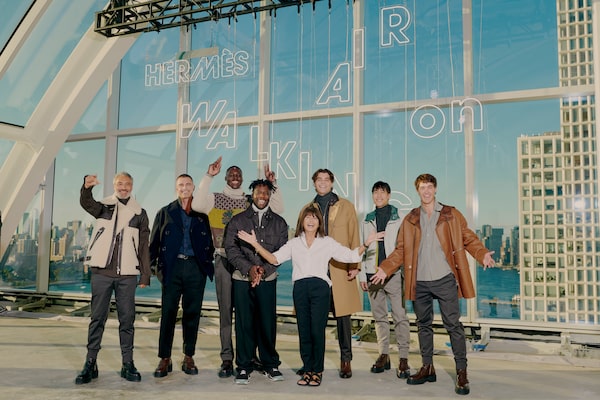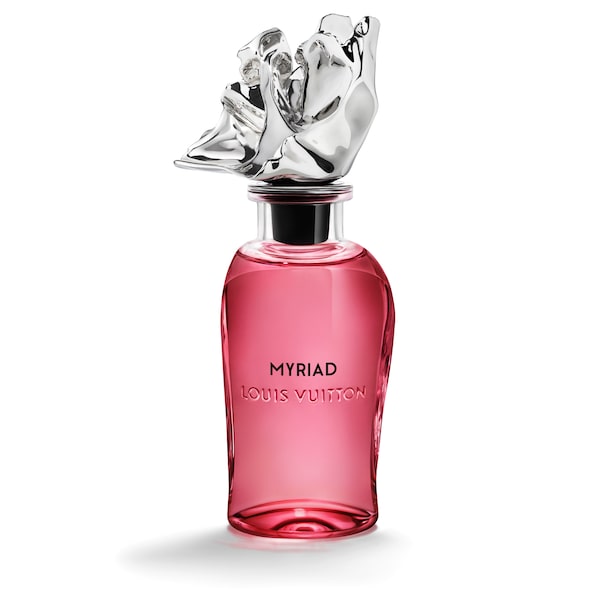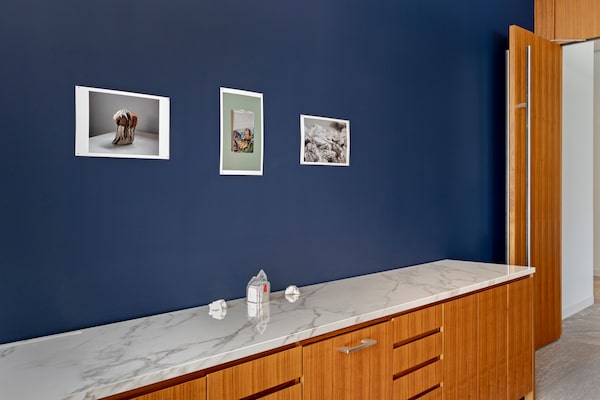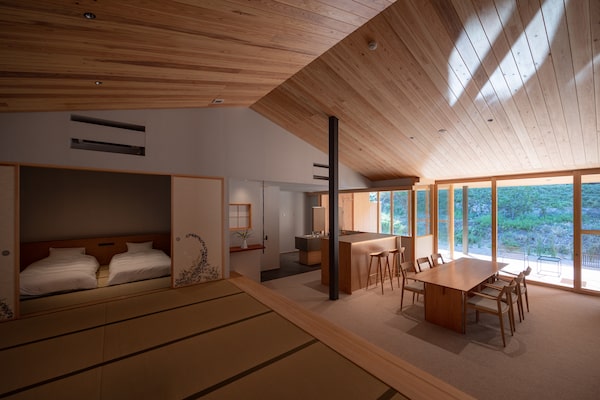Here’s what’s new and noteworthy from Style Advisor’s desk in November, from a new fragrance by Louis Vuitton to Pandora’s foray into lab-created diamonds.
FASHION
Hermès’ Véronique Nichanian has been designing discretely decadent men’s wear for decades

"I try to pose things to men that will make them more seductive, sexy, smart," says Véronique Nichanian.Supplied
“Fashion is fun but to find your own personality and your own clothes and to mix your clothes to express what you are inside and to put your stamp – I love that,” says Véronique Nichanian. The artistic director of men’s wear at Hermès made the statement in mid-September on the eve of a presentation of her fall collection in New York. Staged at the revamped Domino Sugar building in Brooklyn with the Manhattan skyline lit by a cinematic sunset as its backdrop, the show featured models and notables – director Taika Waititi, tennis star Taylor Fritz – in cozy outerwear and knits detailed to look like a long-loved piece that had been carefully repaired. Here, Nichanian talks about building a wardrobe and how traditional craft sparks innovation.
What makes you think about designing for the long term?
I try to pose things to men that will make them more seductive, sexy, smart. To feel comfortable, it’s very important. I don’t want them to change themselves. I just propose some clothes. My difference is that I pay very close attention to fabrics, colours, proportions.
How does this collection fit into your body of work?
It’s like a book, season after season. I’m writing a story. My inspiration was a very dark colour palette, it’s true, but talking about what I love at Hermès – the bags we do, the scarves and everything – my clothes are staying for a long time. I love the durability of things. This collection was an expression of the way something you love like an old sweater or a jacket, the way you want to keep it…the way you can repair it.
A lot of people think about preserving craft as a nostalgic thing but it moves things forward too.
It’s fantastic to have the new expression of the craftsperson … just taking the time to do something beautifully. Not to rush. For me, the modernity is that twist in the way you mix things.
How does incorporating the expertise of Hermès craftspeople influence your design process?
When you go into the atelier to see how everything is done, you say, “wow,” because they are people that are in love with what they’re doing. They’re proud of what they’re doing and I’m proud of what I’ve done with my team. It’s important that you do something with passion. – ANDREW SARDONE
This interview has been edited and condensed.
For more information, visit hermes.com.
FRAGRANCE
For its latest Les Extraits scent, Louis Vuitton creates a woodsy standout

Myriad, $715 at Louis Vuitton (louisvuitton.com)Supplied
In 2021, architect Frank Gehry and Louis Vuitton master perfumer Jacques Cavallier Belletrud teamed up on a new perfume offering called the Louis Vuitton Les Extraits Collection, a series of five fragrances housed in striking flacons designed by Gehry to resemble an abstract flower. As a group, the fragrances offer a reimagining of perfume that leaves behind the traditional structure of top, heart and base notes to focus instead on a beloved essence such as floral, musk, citrus, chypre or amber.
This season, a sixth option joins the collection. Myriad is an ode to oud wood, a precious ingredient beloved around the world for its mysterious allure (Louis Vuitton sources its essence of Assam oud from a supplier in Bangladesh). To enliven its intense aroma, the master perfumer endeavoured to pair it with elements of light, adding in rose absolute from Grasse (the perfume capital of France that Cavallier Belletrud’s family has called home for generations), saffron and cocoa to create what he describes as “a perfect balance between the woody, spicy depth of oud and its characteristic animalic note.”
Gehry and Cavallier Belletrud share a passion for the natural world, using biomimicry to bring tangible substance to the abstract ideas of their respective metiers. “Frank and I both love the wind that gusts through the world around us. We love movement and fluidity, two notions that are at the heart of the Les Extraits Collection,” Cavalier Belletrude says. “Nature is our guide.” – CAITLIN AGNEW
JEWELLERY
Pandora’s grown diamonds will gauge how far interest in manufacured stones goes

Pamela Anderson stars in the Diamonds for All campaign for Pandora.Mario Sorrenti for Pandora/Supplied
Pandora, the world’s largest jewellery company, has entered the world of lab-created diamonds. Three new collections are meant to explore the sustainable potential of manufactured stones and open the growing bauble category up to a wider audience. PandoraNova is a design-forward line with asymmetric stone settings. Pandora Talisman is a new take on the charms that are the brand’s bread and butter. And Pandora Era is a reimagining of two classic stone settings: bezel and prong. “With the new designs we wanted to capture a fragment of light, suspended in the air, protected yet free,” says Francesco Terzo, who serves as Pandora’s creative director alongside A. Filippo Ficarelli. “It’s like we’re harnessing light from the sky, in our own way.”
In Pandora’s labs, each diamond is grown, cut and polished using 100-per-cent renewable energy and crafted with 100-per-cent recycled silver and gold. According to the brand, this makes a stone’s carbon footprint around 95 per cent less than a mined diamond of the same size.
Despite consumer skepticism about what makes a “real” diamond and whether lab options qualify, the brand is optimistic about changing shoppers’ minds. “Some would say, ‘this isn’t the same because of the traditions,’ others will say, ‘wow this is great because it’s new, it’s innovation, its sustainability. I want the newness.’ And so it’s just reflecting that this generation of consumers has different preferences.” says Mads Twomey-Madsen, Pandora’s senior vice-president of communications and sustainability. “We’re democratizing a product that has had a set way of being viewed and being purchased, hopefully reaching more consumers overall and hopefully also changing the way we will wear them.” – NADIA PIZZIMENTI
For more information, visit pandora.net.
DESIGN
The DesignTO festival spotlights how matter influences meaning in art and design

The 2024 DesignTO festival will bring together a multidisciplinary array of pieces that capture nuanced narratives around sustainability, racism and innovation through their materiality.Toni Hafkenscheid/Supplied
From Jan.19 to March 31, Harbourfront Centre in Toronto hosts Future Matters, a group exhibition that’s the centrepiece of the city’s annual DesignTO Festival. The show brings together a multidisciplinary array of pieces that capture nuanced narratives around sustainability, racism and innovation through their materiality.
There will be melted sugar “machetes” crafted by Yassine Ben Abdallah for the installation The Bittersweet Memory of the Plantation, which reflects on colonialism and cultural preservation. Artist Cole Swanson’s investigation of ecological precarity and urbanization is revealed through documenting groves of staghorn sumac found along Toronto’s Rail Path trail.
Julia Rose Sutherland will present work that contributes to a series she started in 2021. Called Wisgipg (fire ash), it’s comprised of a collection of books that Sutherland accumulated while on a three-month residency at The BEMIS Center for Contemporary Arts in Omaha, Neb. The volumes have been dipped in porcelain slip and then ceremonially burned in a kiln to create the delicate sculptures, pictured here.
Sutherland, a Mi’kmaq (Metepenagiag Nation)/settler artist, says she would come across what she describes as “colonial smut” – titles including Dan Cushman’s The half-caste and My life as an Indian by J.W. Schultz – while at second-hand stores in Omaha, and found them disturbing yet motivating. “Western expansion and its relation to Indigenous people was there in my face, written from a colonial perspective,” she says. “And I just couldn’t help but think, we should just burn this.” Sutherland says it’s a particularly potent gesture as an act of reclamation and rebirth.
“We’re craftspeople, so whether we’re touching things, or in our relationship to objects, materiality is really important,” she says. “Some people find material inspiration first; I start from a core idea, and then find what is going to bolster that in the most impactful and authentic way.” –ODESSA PALOMA PARKER
For more information, visit designto.org.
TRAVEL
On Japan’s art island, one inn stands out for bringing a creative spirit home

Roka is one of Naoshima’s newer stays and the island’s first, full-scale luxury ryokan.KENJI KUDO PHOTOGRAPHY/Supplied
The trip through Japan to arrive on Naoshima Island can often include multiple buses, a train or two and one Yayoi Kusama-spotted ferry ride. That last leg of the journey through the Seto Island Sea makes it clear that you’re headed for one of the world’s top art destinations, which is also home to some of Japan’s more striking hotels.
Roka is one of Naoshima’s newer stays and the island’s first, full-scale luxury ryokan. Immersed in a green landscape and rock garden, the inn’s design ethos is plain to see: a hamlet-style campus of minimalist buildings with vague borders denoting the line between indoor and outdoor spaces that respect the traditional aesthetics of Japan. There is an outdoor hearth where guests can sit and chat about their travels and an accommodation wing separated by a wall of charred cedar boards and inspired by the Nagaya style of communal housing. Guests catch glimpses of their neighbours (spotting a shoe propped up on a windowsill; hearing an outdoor shower or some quiet chatter; being wowed by their kaiseki spread in the restaurant.), which serves as a reminder that the hotel is full of travellers experiencing the island together. For more private moments, each room is equipped with its own onsen.
Art at Roka reveals itself incrementally and inconspicuously. The back garden features a bamboo installation that winds around the trees and is meant to evoke a breeze blowing through a lush environment. Pieces from emerging Japanese artists are found throughout the inn and are available to purchase as a way to immerse guests in contemporary art by having it become part of the fabric of their stay – and departure. –NADIA PIZZIMENTI
Stays from $460/night including kaiseki dinner and breakfast. For more information, visit roka.voyage.
Style Advisor travelled to New York as a guest of Hermès and to Copenhagen as a guest of Pandora. The companies did not review or approve this article prior to publication.